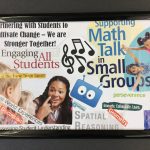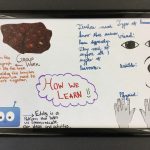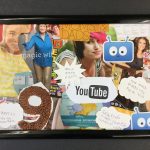Our school has a diverse population of students from different socioeconomic backgrounds, learning abilities and learning needs. “Attention to spatial reasoning can provide additional entry points into mathematics for all children and improve their prospects for the future and success in later life.” (Paying Attention to Spatial Reasoning, p. 7)
Our goal is to help students develop their spatial reasoning skills in mathematics and other content areas. A variety of strategies are used to help our students of diverse needs improve their abilities to visualize, verbalize and verify their thinking. We identified a continuum of spatial reasoning skills across all strands of the math curriculum. We created rich tasks and documented the student thinking as they engaged in their work. During focus group meetings, we further partnered with our students to deeply understand what is important and what impacts their mathematic learning.
Team Members
Helena Trussler
Greater Essex County District School Board
Minelle Toussaint-Greene
Greater Essex County District School Board
Teresa Champagne
Greater Essex County District School Board
Barb Dello
Greater Essex County District School Board
Brenda Del Duca
Greater Essex County District School Board
Professional Learning Goals
- Through research and student study, we gained a better understanding of how spatial reasoning skills can promote students’ understanding of measurement and geometry
- Through research, we gathered or created effective learning activities that will increase students’ spatial reasoning skills with the use of manipulatives and iPads apps
- Through observations and conversations, we have a better understanding of how students visualize, perceive and solve problems. We will then be able to provide better teaching strategies and learning activities to help students gain independence in learning and solving problems.
Activities and Resources
To begin with, we did some research to further our understanding of what spatial reasoning is. We used the Ministry Document “Paying Attention to Spatial Reasoning” and engaged in some of the activities ourselves. Another valuable resource we used to begin our planning was Taking Shape: Activities to Develop Geometric and Spatial Thinking by Beverly Caswell, Catherine Diane Bruce, Joan Moss, Tara Flynn and Zachary Hawes. We viewed and read some of the spatial reasoning resources found on The Learning Exchange website (thelearningexchange.ca).
As a result, we became more aware of finding spatial reasoning tasks that help students develop these skills right across the curriculum, within the classroom, the learning commons, the gym and the music room.
We spent time analyzing student work to uncover their spatial reasoning skills and thinking. This analysis combined with student focus groups gave us invaluable information about what supports our students’ spatial reasoning skills, and what still needs to be done.
Unexpected Challenges
At first, we tried to align tasks within the linear measurement strand across the primary and junior divisions. It was challenging because once you reached the upper junior grades, they focus more on standard measurements. We then wondered if there is time and value of starting each unit with some non-standard measurement activities. However, a lack of time makes it difficult.
Enhancing Student Learning and Development
All our learners of focus demonstrated that visualizing, verbalizing and verifying using manipulatives help them in one way or another. This was evidenced by our junior learners using the language of instruction, while our primary learners demonstrated their spatial thinking using gestures and their documented student work and conversations.
A Grade One student said, “You look at it (moves hands, gestures) and then it goes to your brain and then you keep that picture in your brain and you count it and then you estimate it. Your eyes see it, and it sends a message to your brain, and then you can see it and count it and estimate it.
When I’m visualizing, I like it better than seeing it. When I visualize it, I take the problem and I see it in my mind. When you see it in your head, it kind of makes more sense.”
The more that we partnered with our learners, the more confidence the students showed in their learning and understanding.
Listening to our students during our focus groups also made visible to us the importance of the continuum of learning.
The more we value and engaged our students in conversations about mathematics pedagogy, the more precise our instruction can be to meet their learning needs.
Sharing
- Our TLC is connected to our SIPSA, and the SIPSA is connected to our TLC so, therefore, there is reciprocity of learning across our professional learning communities at school
- We have shared at staff meetings, monthly Math Mondays, Edsby and Twitter
- We planned to create a video of student voices regarding how they best learn math in our school for our new principal and colleagues
- We will post collages created by our learners of focus to remind us of how they learn math. QR Codes will be used to listen to their voice.
Project Evaluation
- We are more confident in choosing effective teaching strategies and learning activities to increase their spatial reasoning skills (e.g., gesturing, 3Vs, concreteness fading)
- We have a better understanding of how students use their spatial reasoning skills (e.g., when they use gesturing)
- Teachers from primary and junior divisions will communicate regularly to discuss lessons that enhance spatial reasoning skills
Resources Used
Moss, J., Bruce, C.D., Caswell, B., Flynn, T. and Hawes, Z. Taking Shape: Activities to Develop Geometric and Spatial Thinking Grades K-2, 2016.
Ontario Ministry of Education. (2005). The Ontario Curriculum, Grades 1-8: Mathematics.
The Learning Exchange. (2015). Spatial Reasoning in Number Sense and Numeration.
Retrieved from http://thelearningexchange.ca/projects/spatial-reasoning-number-sense-numeration/?pcat=999&sess=1
Ontario Ministry of Education LNS Monograph. (2014). Paying Attention to Spatial Reasoning.
Retrieved from http://www.edu.gov.on.ca/eng/literacynumeracy/LNSPayingAttention.pdf
Ontario Ministry of Education. (2007). A Guide to Effective Instruction in Mathematics Kindergarten to Grade 3: Measurement.
Retrieved from http://oame.on.ca/eduproject/ontariomathedresources/files/Measurement%20K-3.pdf
CPALMS. Elapsed Time.
Retrieved from http://www.cpalms.org/Uploads/resources/49901/1/5/docs/elapsedmountain.pdf
Resources Created
These resources will open in your browser in a new tab, or be downloaded to your computer.




